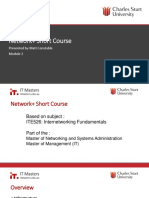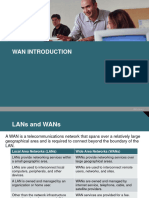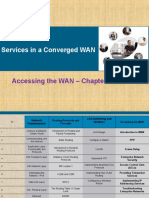Module 1
Introduction to WANs
�Objectives
Describe how the Cisco enterprise architecture provides
integrated services over an enterprise network.
Describe key WAN technology concepts.
Select the appropriate WAN technology to meet different
enterprise business requirements.
�Providing Integrated Services
to the Enterprise
�Introducing Wire Area Network
The three major characteristics of WANs:
WANs generally connect devices that are separated by a broader
geographical area than can be served by a LAN.
WANs use the services of carriers, such as telephone companies, cable
companies, satellite systems, and network providers.
WANs use serial connections of various types to provide access to bandwidth
over large geographic areas.
�The Evolving Enterprise
A Growing Business and Its Network
�The Evolving Enterprise
A Growing Business and Its Network
�The Evolving Enterprise
A Growing Business and Its Network
�The Evolving Enterprise
A Growing Business and Its Network
�The Evolving Enterprise
The Hierarchical Network Model
�The Evolving Enterprise
The Hierarchical Network Model
10
�The Evolving Enterprise
The Enterprise Architecture
11
�The Evolving Enterprise
The Enterprise Architecture Example
12
�WAN Technology Concepts
�WAN Technology Overview
14
�WAN Physical Layer Concepts
WAN Physical Layer Terminology
15
�WAN Physical Layer Concepts
WAN Devices
16
�WAN Physical Layer Concepts
WAN Physical Layer
17
�WAN Data Link Layer Concepts
WAN Datalink Protocol
Router(config)#interface serial slot/port number
Router(config-if)#encapsulation ppp| hdlc| frame-relay
18
�WAN Data Link Layer Concept
HDLC Frame
01111110
01111110
Layer2
Address
Information
or Control
Layer3
Protocol
(IP, IPX)
19
�WAN Switching Concept
Circuit-switched network
A circuit-switched network is one that establishes a dedicated circuit (or
channel) between nodes and terminals before the users may communicate
The internal path taken by the circuit between exchanges is shared by a
number of conversations. Time division multiplexing (TDM) gives each
conversation a share of the connection in turn. TDM assures that a fixed
capacity connection is made available to the subscriber.
20
�WAN Switching Concept
Packet-switched network
An alternative is to allocate the capacity to the traffic only when it is needed,
and share the available capacity between many users.
Packet-switching networks do not require a circuit to be established, and
they allow many pairs of nodes to communicate over the same channel.
Because of shared the circuit, there must be some mechanism to label the
bits so that the system knows where to deliver them.
It is difficult to label individual bits, therefore they are gathered into groups
called cells, frames, or packets.
21
�WAN Link Connection Options
�WAN Link Connection Options
23
�Dedicated Connection Link Options
Leased Line
24
�Circuit Switched Connection Options
Analog Dialup
25
�Circuit Switched Connection Options
ISDN
Integrated Service Digital Network
The connection uses 64 kbps bearer channels (B) for carrying voice or data
and a signaling, delta channel (D) for call set-up and other purposes.
26
�Packet Switching Connection Options
X.25
The first of these packet-switched networks was standardized as the X.25
group of protocols.
X.25 link speeds vary from 2400 b/s up to 2 Mb/s. However, public networks
are usually low capacity with speeds rarely exceeding above 64 kb/s.
X.25 networks are now in dramatic decline being replaced by newer layer 2
technologies such as Frame Relay, ATM, and ADSL.
27
�Packet Switching Connection Options
Frame-Relay
Frame Relay offers data rates up to 4 Mb/s, with some providers offering even higher
rates
Frame Relay virtual-circuits (VC) are uniquely identified by a DLCI, which ensures
bidirectional communication from one DTE device to another
Most Frame Relay connections are PVCs rather than SVCs.
Frame Relay provides permanent shared medium bandwidth connectivity that carries
both voice and data traffic.
28
�Packet Switching Connection Options
ATM
Asynchronous Transfer Mode (ATM) technology is capable of transferring voice,
video, and data through private and public networks
It is built on a cell-based architecture
ATM cells are always a fixed length of 53 bytes
ATM was designed to be extremely scalable and can support link speeds of
T1/E1 to OC-12 (622 Mb/s) and higher.
29
�Broadband Service
DSL Digital Subscriber Line
DSL technology is an always-on connection technology that uses existing twisted-pair
telephone lines to transport high-bandwidth data, provides IP services to subscribers.
A DSL modem converts an Ethernet signal from the user device to a DSL signal
30
�Broadband Service
Cable Modem
Coaxial cable is widely used in urban areas to distribute television signals.
This allows for greater bandwidth than the conventional telephone local loop.
Enhanced cable modems enable two-way, high-speed data transmissions
using the same coaxial lines that transmit cable television.
Cable modems provide an always-on connection and a simple installation.
31
�Broadband Service
Broadband Wireless
WiMAX
Described in the IEEE standard 802.16
WiMAX operates in a similar way to WiFi, but at higher speeds, over greater
distances (10 miles), and for a greater number of users.
It uses a network of WiMAX towers that are similar to cell phone towers
Satellite Internet
The upload speed is about one-tenth of the 500 kb/s download speed
To access satellite Internet services, subscribers need a satellite dish, two modems
(up and down), and coaxial cables between the dish and the modem
32
�VPN
Virtual Private Network (VPN) is defined as network connectivity deployed on a
shared infrastructure with the same policies and security as a private network.
A VPN can be between two end systems, or it can be between two or more
networks.
A VPN can be built using tunnels and encryption. VPNs can occur at any layer of
the OSI protocol stack.
A VPN is an alternative WAN infrastructure that replaces or augments existing
private networks that use leased-line or enterprise-owned Frame Relay or ATM
networks.
There are two types of VPN access:
Site-to-site VPNs
Remote-access VPNs
33
�Internet Connection Options
Site-to-site VPNs
34
�Internet Connection Options
Remote-access VPNs
35
�Internet Connection Options
Metro Ethernet
Extending Ethernet to the metropolitan area
Metro Ethernet is a rapidly maturing networking technology that broadens
Ethernet to the public networks run by telecommunications companies.
IP-aware Ethernet switches enable service providers to offer enterprises
converged voice, data, and video services such as IP telephony, video
streaming, imaging, and data storage
36
�Good luck with this module!






























































































